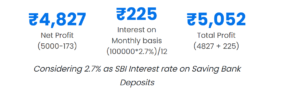Lowest Brokerage Charges Demat Account
Whether there is novice or an experienced trader, requirements from the market regardless of profitability, have undergone significant shifts, and the markets have adjusted to accommodate these shifts. The Indian broking industry saw a massive disruption between Discount brokers and full service brokers.
For those who are interested in and have the time to learn the ins and outs of stock market trading on their own, a discount brokerage service may be the best option. Such a service gives you access to the stock market and the tools necessary to trade, but does not include any advisory or other services. Others, though, may wish to invest in the stock market but lack the time to understand the basics. It’s possible that a full service brokerage account with all the bells and whistles would be more useful here. Obviously both have different cost structures for their clients.
Because discount brokers offered Low brokerage charges that was more cost effective, they were able to successfully compete with traditional brokers who charged higher commissions and fees. In reaction to this rivalry, several of the well-established brokers and organisations started offering their own schemes that were comparable to the other options but more affordable. Although it has been close to a decade since discount brokers were first brought to general attention, the popularity of these brokers has recently experienced a boom.
In point of fact, multiple low-cost brokers have the potential to compete with and even outperform the major, well-established “conventional” trading companies only on the basis of lowest brokerages. As a result, these conventional brokers have either already implemented the discount broking model inside their own operations or are in the process of making the necessary preparations to do so.
With a low brokerage demat account, you not only prevent your profits from being burned within seconds, but you can even prevent your losses from becoming too bad to digest. But why lowest brokerage charges demat account matters? This guide is here to provide you with detailed information on this important topic that is rarely discussed. Without further ado, jumping straight to the topic
Lowest Brokerage Charges: Why Do They Matter?
Low brokerage charges lessen the burden of trading and investment to a great extent. If you are a seasoned investor, you might be familiar with the fact that risk and reward go hand in hand in the stock market.
There is no certainty of loss and profit in stock market. Still, loss is never acceptable, and when it is compounded by additional negative figures in the form of brokerage fees, it literally wrecks havoc on your mind and financial profile.
Even if you make small profits in the second scenario, you still have a good chance of turning them into a loss because nothing can stop the broker from making deductions. For all these reasons, you should invest your time first in finding the best low brokerage trading app or platform.
The lowest demat account charges or lowest brokerage charges app may provide a sign of mental satisfaction. Moreover it can help you gain clarity on the upcoming losses and profits with the assurance that they will be more cost effective.
If you are a day trader making thousands or lakhs every day and giving up a big chunk of your hard-earned money to the broker, you already know the importance of a low brokerage trading account or the lowest brokerage charges for F&O. You may check our pricing plans or open an online demat account by downloading a mobile trading app or contacting the broker through the website.
Understanding brokerage charges
When it comes to reducing the amount of money spent on brokerage fees, discount brokers are your best bet. The pricing plans for discount broker currently are quite straightforward. They apply the same flat (fixed) brokerage cost to all of their clients’ trades, regardless of the volume of such trades. It is typical for this cost to range between Rs 10 and Rs 20 for each order. On the other hand, a full-service broker will only charge a percentage of the total number of transactions in exchange for their services. There is a possibility that delivery transactions will incur fees ranging from 0.25 percent to 0.7 percent of the entire amount traded. You may check and compare our brokerage plans here
Brokerage charges are paid by investors twice in the trading process. Simply put, a particular brokerage commission is charged by the broker when you buy a share and again when you sell it.
The charge rate, however, varies depending on the brokerage platform. But if you are wondering how these charges are calculated, this example may make it easier for you.
Imagine a broker charging a fee rate of 0.05% on intraday orders. In other words, this would imply a 0.05% charge on the total turnover. If the cost of a single stock is Rs 100, you would be paying Rs 0.50 per stock.
You would pay Rs 0.05 + Rs 0.05 = Rs 0.10 for a single stock if both the buying and selling processes were combined. But that’s just an example; the real-world brokerage charges are even worse because of added fees, as discussed next. Take a look:
Types of Brokerage Charges: Explained
-
Brokerage
Brokerage is typically used for the fee charged by a broker for their trading services. However, most discounted brokers provide relief to traders by offering the lowest brokerage in option trading. Still, they apply in most places. In India, there are 3 types of brokerage plans that are popular now:
- Brokerage as a percentage of trading volume
- Monthly trading plan
- Flat per trade brokerage
There are dozens of stock brokers in the market; each may have a different brokerage plan, so the terms of charges can vary significantly.
-
Transaction Charges
Transaction charges are quite obvious. These charges may not levy by the broker but could have been levied by the exchanges like BSE, NSE, etc. The charge combines both clearing charges and exchange turnover charges. Transaction charges vary in cash and futures and option segment. There’s no way to avoid them; the only thing you can still keep in mind are the lowest brokerage fees and no transaction charges from the broker’s side.
-
Securities Transaction Tax
STT (Securities Transaction Tax) is a small fee payable on the value of securities, e.g., equity delivery, equity intraday, equity F&O, currency, commodities, etc. The charge is levied on the sell-side in both futures and options trades and is levied on both sides in delivery trades.
-
Commodity Transaction Tax
CTT (Commodity Transaction Tax) is a small fee charged exclusively on commodity derivatives in India. In the same manner as the purchase and sale of securities in India’s secondary markets are subject to the security transaction tax (STT), the purchase and sale of commodities contracts on India’s commodity exchanges are also subject to the Commodity Transaction Tax (CTT).
CTT applies to all commodity trades. Non-agricultural commodity derivative contracts are subject to a CTT (commodity transaction tax) of 0.01% of the trade price. Both the buyer and the seller must pay the tax. The levy is based on the whole value of the contract. The CTT does not apply to the exchange of food and agricultural products. Commodities such as natural gas, silver, Brent oil, crude oil, and gold are subject to taxes.
-
Stamp Duty
You might have noted that stamp duty is charged along with the Low brokerage charges in India. state governments levy stamp duty on documentation related to securities transactions, and like GST, these charges are unavoidable as well.
-
-
GST Tax
-
India’s government imposes GST on services offered within its borders. A total brokerage charge plus transaction fees is subject to 18% GST on securities transactions, which can readily obstruct the lowest trading charges.
-
SEBI charges
All transactions in securities other than debt securities are subject to a fee charged by SEBI, the securities market regulator in India. For now, a fee of Rs 5 per crore is charged, which rarely impacts your brokerage charge.
For more understanding please Click Here
Best Tips to Choose the Lowest Brokerage Trading Account
Given below is a breakdown of tips you can use to find the lowest brokerage trading account. However, these tips might not help in getting a free-of-charge broking platform, but they can give you peace of mind that the ultimate option will adapt to your choice.
Research and Compare
Researching and comparing is one of the best methods to finally find the right brokerage platform to invest in. Ideally, there’s no stock broker with the lowest fees, but some brokers are serving value to customers with budgetary solutions.
As such, most discounted brokers are known as the lowest margin brokers for option selling and buying. These brokers are monopolising the option market. However, they may have certain shortcomings, such as option services that aren’t that appealing.
Since decision can’t be influenced purely by lowest intraday charges, it’s worthwhile to run a comparison between two prospective broking platforms you are setting higher expectations from.
It is worthwhile to compare the lowest DP broker charges because depositary participant charges may add more volume to trading charges. So get two or three prospective names and compare them with each other right away.
Prioritize Online Trading Platforms
Whether you are looking for the lowest brokerage in F&O or in equities, you must prioritise online brokers over offline brokers. Online brokerage firms minimise or eliminate charges entirely from the equations that were supposed to be a headache in the traditional broking system. You can access the lowest AMC charges for a demat account because most activities on online brokerage platforms happen electronically, which lessens the need for manual activities.
With this, you even access lowest dp charges and lowest intraday brokerage charges because the overall data is streamlined. Similarly, time and cost consuming activities are eliminated from the process entirely.
A tech-enabled broking platform can even lower brokerage fees because the services are remotely shared with a large customer base, making it easier for the broker to reduce its personal commission.
Analyze the Best Product in Offer
In most events, the product or services offered by a stock broker values more than the consideration for low margin broker. In the second scenario, if you are a big trader, bidding on assets that are worth lakhs and crores of rupees, the best trading app with low brokerage might not be a great alternative for you.
Rather than scouting for the best demat account with low charges, you should find a broker that’s more promising, offering vigorous safety to your wallet and investment. Their best products sometimes overshadow their pricing.
Thoroughly review services
If the product or service from the broker is something that’s more valuable for you, you should dive deeper into reviewing the service, regardless of whether it’s from a broker with the lowest brokerage or not.
In most cases, brokers provide some extra helpful services to clients. Such as, expert assistance, giving updates to clients, timely delivery of agreement, and many other facilities are offered in addition to lowest trading brokerage charges.
So rather than getting influenced by these additional factors, it’s worth understanding what exactly your requirements are. The lowest delivery brokerage could be a need, but extra services are a choice.
Regardless of how low their commission and fee structures are, most trading apps with the lowest brokerage fees provide excellent services.
Evaluate additional charges
The discount model is extremely popular in the world of online trading. Some brokers may have successfully captured your attention, but it is unknown whether or not they are the lowest commission stock broker.
It has been seen that most stock brokers put forward additional charges such as account opening charges, DPS charges, and account maintenance charges that are indeed the main income source.
They are may be offering the best low brokerage trading account charging zero to extremely low brokerage on trades, still you should remember one thing that broking apps or websites are genuine.
In a nutshell, instead of delving into the lowest brokerage’s intraday trading, it would be better to evaluate additional services and charges.
However, as previously stated, some charges are unavoidable, such as SEBI charges and the GST levied by the Indian government. So logically analyse whether their offer of low brokerage trading is legit or whether some hidden tricks are available behind the door.
Customer feedback could be beneficial.
Customer reviews disclose the unheard or unseen facts of a particular broking platform which might have been well tried to be hidden under lowest share trading brokerage plan.
Some brokers may have created a well-functioning and highly responsive stock market app with the lowest brokerage, but it could be a hoax game preying on the emotions of stock market newcomers.
Simply put, if you are about to rely on a trading platform that isn’t yet used by anyone in the stock market, avoid it right away. Customer feedback indicates that the broking platform has been tried and trusted.
If the value offered by the broker is true to its promises, serving the purpose with utmost precision, customer reviews might get things sorted. What else is covered in the services of a broker claiming the lowest brokerage in the stock market? Reviews are the best source to find them out.
Final Words
Eventually, if you are about to download a low-commission trading app or find a stock broker with the lowest brokerage, make sure you are particular about the topic of charges. A single hike in commissions or fees from your broker can badly affect your financial profile in the stock market. With the lowest brokerage in the stock market, you can minimise the risk of losing your hard-earned money, but with this, you need to make sure that the services offered are also top-notch. You should prioritise quality service over quality brokerage price, especially when bidding for large amounts. Luckily, the market has dozens of the best brokers with the lowest brokerage and the finest services; just a little comparison would be needed.
Why Moneysukh
Moneysukh for the first time introduced industry first concept of “Interest on Ledger Balance”. Until now, traders and investors in the financial markets were only familiar with the concept of paying interest on margin. But now instead of paying clients are getting monthly interest on their funds. You may be wondering how it is possible. Before we get started, let’s go over some concepts.
When an investor or trader wishes to initiate a futures contract, he or she must deposit a specified percentage of the contract’s total value with the broker, which is known as margin money. Margin money is a deposit made to secure a futures contract while it is active. Margin money will be blocked in your trading account for the number of days you decide to hold the futures position. The exchange determines the margin percentage, which fluctuates based on the underlying volatility. Exchanges may adjust the percentage margin amounts at any moment.
Intermediaries play crucial roles in facilitating the transaction when parties enter into a future contract. The broker and the exchange are two of the most essential financial intermediaries.
Assume two parties entered into a futures contract with gold as the underlying. When Russia invaded Ukraine on February 24, 2022, the underlying price, which is gold, skyrocketed. In such a situation, the party who is long on the contract will benefit, while the person on the opposite side would lose. If the short party fails to meet its obligations, it might have substantial financial consequences not just for the short party but also for the broker and exchange.
Here is when the margin comes into play.
The parties to the transaction are unknown to each other. To protect the intermediaries against the client’s default, the exchange mandates the use of taking a sufficient margin. By requiring a margin, the exchange ensures that the loss-making party honor’s his side of the commitment and compensates the opposite side by the amount to which he/she is entitled. SPAN Margin is the minimum required margin blocked under the exchange’s mandate, whereas the Exposure Margin is the margin blocked in excess of the SPAN to cushion potential MTM losses.
Margin Money = SPAN Margin + Exposure Margin
Mark to market (M2M) involves adjusting the account with profit or loss that either party is entitled to for the day. M2M is relevant as long as the futures contract is kept.
Margin For Options Trading
Traders who buy options do not have to pay or deposit margins. They have to pay the premium for the Rights they have bought. Whereas options sellers must deposit a margin in line with the exchange’s requirements. It is because of the sudden volatility and premium they received while entering into the contract.
What is Interest On Ledger Balance
For years, investors and traders kept depositing margins with their brokers for trading, which yielded them absolutely nothing. The notion of interest on ledger balance will assist clients in maximising their returns while keeping deposits always earning anything even when they are not in their savings account. The interest on the ledger balance is applicable to all the clients with cash ledger credit amount irrespective of any margin shortfall. Interest on the ledger balance is applicable on the entire balance in cash form, even if the client uses the margin. There is absolutely no capping on the interest amount of the credit balance. Interest credit will be rounded to the lowest rupee and the interest amount will be credited to the client ledger on monthly basis. You might have a question, how does the concept of Interest on Ledger Balance work? Let us now take on a few scenarios to give you a better understanding of the concept.
Assumed Amount Rs. 1,00,000 Deposited
Scenario 1:
Let’s assume you have Bought 1 lot of Nifty, which required Rs. 1, 00, 000 of margin and eventually squared off the position before or on expiry.
You bought Nifty at 17,500 with a value of Rs. 8, 75,000 and squared off at 17,600 with a value of Rs. 8, 80,000. This resulted in a profit of Rs. 5,000.
Brokerage and regulatory charges came to be Rs. 173. A net profit of Rs. 4827 is made.
You deposited Rs. 1,00,000 as a margin with Moneysukh which was used for trading. The calculation of interest on the ledger balance turns out to be Rs. 1,00,000 @2.7%, the amount turns out to be Rs. 225 monthly as shown in the presentation.
Total profit including Interest on ledger balance resulted in Rs. 4827 + Rs. 225 = Rs. 5052
|
Script |
Lot Size | CMP | Quantity | Total Value |
Margin Required |
|
| Nifty | Buy | 50 | 17,500.00 | 1.00 | 8,75,000 | 1,00,000 |
| Sell | 50 | 17,600.00 | 1.00 | 8,80,000 | ||
| Profit | 5,000 | |||||
| Brokerage & Regulatory Charges | 173 | |||||
| Net Profit | 4827 | |||||
| Interest Earned on Ledger Balance | 100000*2.7%
= 2700/12 = 225 |
|||||

Scenario 2:
Let us assume you have bought Reliance in cash and eventually sold your position.
You bought 40 shares at 2500 with a value of Rs. 1,00,000 and sold at 2600 with a value of Rs. 1,04,000. This resulted in a profit of Rs. 4000.
Brokerage and regulatory charges came to be Rs. 225. A net profit of Rs. 3775 is made.
You deposited Rs. 1,00, 000 in your trading account with Moneysukh, which was used for conducting the transaction. The calculation of interest on the ledger balance turns out to be NIL, as all the funds were utilised in buying shares and nothing stands in the ledger balance.
| Script | Quantity | CMP | Total Value | |
| Reliance | Buy | 40 | 2,500.00 | 1,00,000 |
| Sell | 40 | 2,600.00 | 1,04,000 | |
| Profit | 4,000 | |||
| Regulatory Charges | 225 | |||
| Brokerage Free | 0 | |||
| Net Profit | 3,775 | |||
| Interest Earned on Ledger Balance | NIL | |||
Scenario 3:
Let’s assume you have bought Reliance and eventually squared off your position.
You bought 20 shares at 2500 with a value of Rs. 50,000 and sold at 2600 with a value of Rs. 54,000. This resulted in a profit of Rs. 4000.
Brokerage and regulatory charges came to be Rs. 112. A net profit of Rs. 3,888 is made.
You deposited Rs. 1,00,000 in your trading account with Moneysukh. Rs 50,000 was used in buying shares of Reliance from the cash market and the interest will be credited on the balance amount of Rs. 50,000.
The calculation of interest on the ledger balance turns out to be Rs. 50, 000 @2.7%, which turns out to be Rs. 113 monthly.
Total profit including Interest on ledger balance resulted in Rs. 3888 + Rs. 113 = 4001
| Script | Quantity | CMP | Total Value | |
| Reliance | Buy | 20 | 2,500.00 | 50,000 |
| Sell | 20 | 2,600.00 | 54,000 | |
| Profit | 4,000 | |||
| Regulatory Charges | 112 | |||
| Brokerage Free | 0 | |||
| Net Profit | 3,888 | |||
| Balance Amount | 50,000 | |||
| Interest Earned on Ledger Balance | 50000*2.7%
= 1350/12 = 113 |
|||
Scenario 4:
Let us assume you have bought 20 lots of Nifty option, which required Rs. 1, 00, 000 of margin and eventually squared off your position before or at expiry.
You bought Nifty 18,000 at a premium of Rs. 100 with a value of Rs. 1, 00, 000 and squared off at Nifty 18, 000 at a premium of Rs. 110 with a value of Rs. 1, 10, 000. This resulted in a profit of Rs. 10, 000.
Brokerage and regulatory charges came to be Rs. 235. A net profit of Rs. 9765 is made.
You deposited Rs. 1,00, 000 as a margin with Moneysukh, which was utilised for trading the Nifty option. The calculation of interest on the ledger balance turns out to be NIL as Nifty options were bought and there is no ledger balance left.
| Script | Lot Size | Strike | Quantity | Premium | Total Value | Margin Required | |
| Nifty | Buy | 50 | 18,000.00 | 20.00 | 100.00 | 1,00,000 | 1,00,000 |
| Sell | 50 | 18,000.00 | 20.00 | 110.00 | 1,10,000 | ||
| Profit | 10,000 | ||||||
| Brokerage & Regulatory Charges | 235 | ||||||
| Net Profit | 9,765 | ||||||
| Interest Earned on Ledger Balance | NIL | ||||||
Scenario 5:
Let us assume you have bought 10 lots of Nifty option, and eventually squared off your position.
You bought Nifty at 18,000 with a value of Rs. 50,000 and squared off at 18,000 with a value of Rs. 55,000. This resulted in a profit of Rs. 5,000.
Brokerage and regulatory charges came to be Rs. 115. A net profit of Rs. 4885 is made.
You deposited Rs. 1, 00, 000 as a margin with Moneysukh, which will be used for trading. The calculation of interest on the ledger balance turns out to be Rs. 50, 000 @2.7%, the amount turns out to be Rs. 112.5 monthly as shown in the presentation.
Total profit including Interest on ledger balance resulted in Rs. 4,885 + Rs. 112.5 = 4,997.5
| Script | Lot Size | Strike | Quantity | Premium | Total Value | Margin Required | |
| Nifty | Buy | 50 | 18,000.00 | 10.00 | 100.00 | 50,000 | 50,000 |
| Sell | 50 | 18,000.00 | 10.00 | 110.00 | 55,000 | ||
| Profit | 5,000 | ||||||
| Brokerage & Regulatory Charges | 115 | ||||||
| Net Profit | 4,885 | ||||||
| Interest Earned on Ledger Balance | 50,000*2.7%
= 1,350/12 = 112.5 |
||||||


















No comment yet, add your voice below!